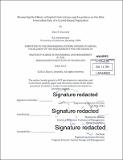Measuring the effects of explicit instructions and incentives on the idea generation rate of a crowd-based population
Author(s)
Donnelly, Allan R. (Allan Richard)
DownloadFull printable version (7.080Mb)
Alternative title
Measuring creative idea generation rates of crowd based populations
Other Contributors
System Design and Management Program.
Advisor
Thomas W. Malone.
Terms of use
Metadata
Show full item recordAbstract
Management researchers have long sought strategies for increasing the rate and quality of ideas generated among workers. Additionally, the advent of internet-based communications has created opportunities for valuable ideas to be generated - and harnessed - from crowds of individuals. The first section of this paper reviews the early and recent literature on measuring creativity, focusing specifically on the effects of incentives and explicit instructions on the rate of idea generation. The following section describes the crowdsourcing platform through which the research was conducted - Amazon Mechanical Turk (AMT) - and reviews recent work that has utilized this platform for experimental research. The project at hand engages participants in a divergent thinking exercise to measure the rate of idea generation for the crowd-based population. The findings show more unique ideas occur later in the response period, demonstrating the presence of the serial order effect; that explicitly instructing respondents to "Be Creative" increases the rate of idea generation; and that offering a bonus incentive for "especially creative ideas" decreases the rate of idea generation for specific demographics of respondents. The paper continues with a discussion of research limitations and areas for further exploration. Conclusions and insights are offered at the end.
Description
Thesis: S.M. in Engineering and Management, Massachusetts Institute of Technology, Engineering Systems Division, System Design and Management Program, 2013. Cataloged from PDF version of thesis. Includes bibliographical references (pages 57-60).
Date issued
2013Department
System Design and Management Program.; Massachusetts Institute of Technology. Engineering Systems DivisionPublisher
Massachusetts Institute of Technology
Keywords
Engineering Systems Division., System Design and Management Program.